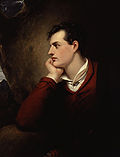Marino Faliero, Doge of Venice
| Marino Faliero, Doge of Venice | |
|---|---|
 First edition title page | |
| Written by | Lord Byron |
| Characters |
|
| Date premiered | 25 April 1821 |
| Place premiered | Drury Lane, London |
| Original language | English |
| Subject | The downfall of Marino Faliero |
| Genre | Historical tragedy |
| Setting | Venice |
Marino Faliero, Doge of Venice is a blank verse tragedy in five acts by Lord Byron, published and first performed in 1821.
Synopsis
[edit]The play is set in Venice in 1355. Marino Faliero, recently elected Doge of Venice, offends one of the chief officers of state, Michele Steno. Steno retaliates by writing on the Doge's throne an indecent libel on Faliero's wife. For this he is tried by the Council of Forty and convicted, but is only sentenced to a month's imprisonment. Faliero is so outraged by this, as he believes it to be an inadequate punishment for such an affront to the ruling Doge, that he secretly joins in the conspiracy of a group of malcontents to abolish the constitution of Venice, thinking thereby to gain revenge on his enemies. The plot is discovered and Faliero is executed.
Composition and publication
[edit]Byron was inspired to take on this subject when, on examining the portraits of the Doges in the Palazzo Ducale in Venice, he discovered that the portrait of Faliero had been blacked out.[1] The main historical source he drew on was Marino Sanuto's Vite dei Dogi (published posthumously 1733).[2][3] He completed the play in July 1820, by which time he was living in Ravenna, and published it in April 1821, along with his The Prophecy of Dante.[4][5] He intended to dedicate it to Goethe, but delays in the post between Italy and England resulted in the play being published without a dedication.[6] The posthumous 1832 edition of Byron's collected works included a later dedication of the play by Byron to his friend Douglas Kinnaird.[7] Marino Faliero was translated into French in 1830 and into Italian in 1838.[1]
First performance
[edit]Byron intended his play to be read rather than acted, and when he heard that the actor-manager Robert William Elliston intended to stage it he caused his publisher, John Murray, to obtain an injunction to prevent him. Elliston nevertheless performed it, in a version cut almost by half, at Drury Lane four days after the play was published. The reaction from both audiences and critics was lukewarm; perhaps, as Byron thought, because of the play's neoclassical form and lack of sensationalism and love interest.[8][9][10]
Influence
[edit]
The subject of Eugène Delacroix' painting The Execution of the Doge Marino Faliero (1825–26), now in the Wallace Collection in London, was suggested by Byron's play.[11][12] A tragedy by Casimir Delavigne on the same subject is believed to have drawn on Byron, as well as on a story by E. T. A. Hoffmann, and Delavigne's play itself inspired Donizetti's opera Marino Faliero.[1] Swinburne was impelled to write his own Marino Faliero by what he considered shortcomings in Byron's play.[13]
Henry De Vere Stacpoole took the name of one of his most famous works, The Blue Lagoon, from this work. The Blue Lagoon, in turn, was adapted into three major motion pictures released in 1923, 1949 and 1980. The first screen adaptation is now lost. The Blue Lagoon, in turn, inspired the title of the 1954 monster horror film Creature from the Black Lagoon.
Notes
[edit]- ^ a b c Plant 2002, p. 91.
- ^ Marchand 1977, p. 131.
- ^ Marchand 1978, p. 161.
- ^ Quennell 1990, p. 596.
- ^ Marchand 1978, pp. 66–69.
- ^ Marchand 1977, p. 206.
- ^ Marchand 1978, p. 195.
- ^ Quennell 1990, p. 653.
- ^ Richardson 2004, pp. 139–41.
- ^ Marchand 1978, p. 66.
- ^ Duffy 2004, p. 240.
- ^ Harrison, Colin. "Delacroix, (Ferdinand-)Eugène(-Victor)". Grove Art Online. Oxford University Press. Retrieved 22 July 2012.
- ^ Ward, A. W. & Waller, A. R. "The Rossettis, William Morris, Swinburne, and Others. § 10. Tristram of Lyonesse". The Cambridge History of English and American Literature in 18 Volumes. Bartleby.com. Retrieved 22 July 2012.
References
[edit]- Duffy, Steven (2004). The Wallace Collection. London: Scala. ISBN 978-1-85759-412-6.
- Plant, Margaret (2002). Venice: Fragile City 1797–1997. New Haven: Yale University Press. ISBN 0-300-08386-6.
venice a fragile city.
- Marchand, Leslie A., ed. (1977). Between Two Worlds. Byron's Letters and Journals, Vol. 7. London: John Murray. ISBN 0-7195-3345-7.
- Marchand, Leslie A., ed. (1978). Born for Opposition. Byron's Letters and Journals, Vol. 8. London: John Murray. ISBN 0-7195-3451-8.
- Quennell, Peter, ed. (1990) [1950]. Byron: A Self-Portrait. Oxford: Oxford University Press. ISBN 0-19-282754-5.
- Richardson, Alan (2004). "Byron and the Theatre". In Bone, Drummond (ed.). The Cambridge Companion to Byron. Cambridge: Cambridge University Press. ISBN 0-521-78146-9.
External links
[edit]- Full text at the Internet Archive
